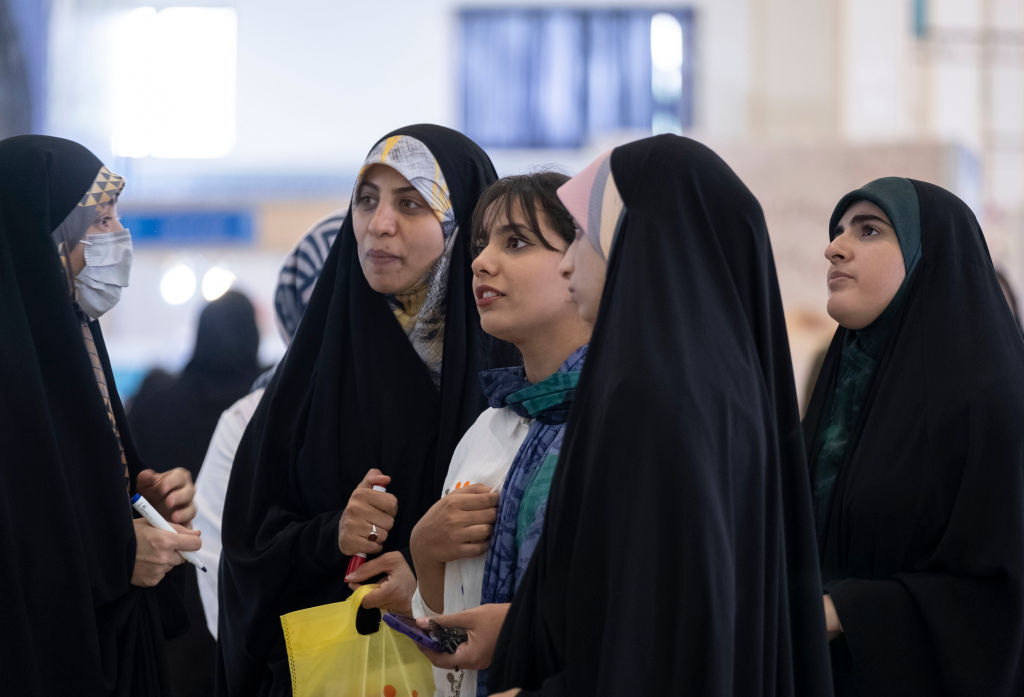
This story was originally published on PassBlue.
Nationwide protests convulsing Iran triggered by the death of Mahsa Amini in police custody last September have tapered off, but as the women-led uprising recedes from the streets, a new spectacle is dominating slowly. It is unnerving the authorities once again.
In the post-Woman, Life, Freedom movement, women are scrapping their headscarves in growing numbers and appearing in public without the compulsory hijab. The government has not reinstated the morality police to go after the women but has instead conjured up new ways of enforcing the hijab with economic repercussions.
The measures include shutting down venues and businesses that cater to women who don’t wear a headscarf and conditioning public services on women complying with the mandate. Having learned from the failed experience of the morality police that spurred the outburst of anger engulfing the entire country last year, the government is minimizing its direct contact with women in the new round of its cultural war. It is outsourcing the policing role to business owners and public service providers.
In the eyes of many Iranians, raising the stakes on the hijab fault line means the government is deliberately fracturing the society and setting different groups of people against one another. For a government that has hardly forsaken its dogmas in the past four decades, however, there is more to the hijab battle than meets the eye.
Tensions soared after the Supreme Leader Ayatollah Ali Khamenei explicitly touched on the debate on hijab compliance in an April 4 public meeting with the government officials, arguing that the renouncement of hijab is both religiously and politically “haram”—forbidden in Islam. It was the first time he used the term “political haram,” which probably means he considers women rejecting the compulsory hijab as an act of defiance against the government.
Religious intellectuals and political scientists agree that in the eyes of the Islamic republic, women’s dressing preferences is no longer a gauge of religiosity or modesty but a political signal revealing how much the government can control public behavior and broader social freedoms.
Every day, new reports emerge about shopping centers, theaters, coffee shops, libraries, resorts and retailers being closed by the police in response to some women showing up without a headscarf. Aside from the overwhelming backlog that would be incurred by the judicial authorities to deal with the bans and decisions on unsealing the businesses, the costs for owners are remarkably high in a wobbly economic landscape. The government has apparently not considered a potential public discontent.
According to Shargh Daily, a popular reformist newspaper, in the first month of the Iranian calendar, starting March 21, nearly 2,000 businesses were closed nationwide for serving unveiled women. In one instance, the Opal Shopping Center in Tehran, an upscale complex of 450 stores, was closed on April 25 and reopened five days later, after its executives committed to preventing hijab “violations” from recurring.
BBC Persian estimated that in the week ending April 30, a total of 500 businesses in various Iranian cities were forced to close as part of the government crackdown on enforcing the hijab. The closings are mostly temporary, but they take their toll. Food courts operated by some of the country’s popular celebrities, such as the Bab Al-Bahr Restaurant, which is affiliated with the former national soccer team star Alireza Mansourian, was recently shuttered.
In the first month of the Iranian calendar, starting March 21, nearly 2,000 businesses were closed nationwide for serving unveiled women.
Videos have been circulating on social media showing the municipalities of Tehran and other major cities guarding metro stations to intercept women without the hijab, asking them to wear their headscarves to board a train. The Ministry of Cultural Heritage, Handicrafts and Tourism told museums nationwide to deny entry to women who don’t have a headscarf on. Legal experts say the government targeting women with such bans is unconstitutional.
Mohsen Borhani, a senior lawyer with a large base of followers on social media, wrote in a tweet on April 29, “it has been stated time and again that sealing off commercial centers because of their customers’ non-compliance with the hijab has no legal foundations. This is an illegal action and is implemented unjustly, and they have just been making an incursion into parts of the private sector.”
Borhani is widely detested by Iran’s hardliners because he has been actively debunking the illegal aspects of the government crackdown over the past months using technical, unsensational language, aiming to ensure citizens of their rights.
Restrictions have affected some of Iran’s household names in the hospitality sector. Ameri House, in the city of Kashan, an 18th-century residence that was converted into a five-star boutique hotel in 2014, was shut in March because some clients hadn’t donned a headscarf. The forest park in Shur Mast Lake, one of the most attractive spots in northern Iran, bordering the Caspian Sea, was also closed for similar reasons.
In an economy already bearing the brunt of crushing global sanctions and the government’s overall incompetence, the new pressures levied on business owners could be daunting. The government has not released actual figures quantifying the economic loss caused by the closures, but objections to its new practices are gaining traction.
Eshaq Jahangiri, a pro-reform politician and former vice president under President Hassan Rouhani, wrote in an opinion piece carried by several Iranian newspapers that as a result of these actions, “citizens would get anxious, discontent and confused, and the costs of resolving the country’s social and cultural problems would be imposed on the ailing body of the national economy and people’s livelihoods.” He warned that “the continuation of this approach, whose outcomes are unclear and whose damages are obvious, won’t be in the interests of the nation.”
A political scientist says the costs of insisting on the mantra of compulsory hijab are rising, and the government risks plunging itself into a deeper crisis by refusing to revoke its policy. Still, the more moderate factions that have been largely sidelined in the government and the hardliners in power differ on what to do about it.
“We have seen some reformist figures call for a repeal of the mandatory hijab law, while other politicians have grown more aggressive about the necessity of governmental control of hijab in public spaces,” said Sahar Razavi, an assistant professor of political science at California State University, Sacramento.
“Although predictions are difficult to make, I think it’s reasonable to expect this disagreement between the reformists and the hardliners about the implications of the government’s commitment to the policy of compulsory hijab to deepen,” she said in an interview with PassBlue.
“The reformists will of course argue that the resistance to it is unsustainably high and that therefore doubling down on the law will weaken the regime’s legitimacy and long-term chances for survival,” she added. “The hardliners will insist that backing down from compulsory hijab will convey weakness and accelerate any crisis of legitimacy that may be brewing.”
Both groups, she noted “are interested in maintaining the survival of the system, but they disagree on strategy.”
The costs of insisting on the mantra of compulsory hijab are rising, and the government risks plunging itself into a deeper crisis by refusing to revoke its policy.
Razavi, who is also the director of the Iranian and Middle Eastern Studies Center at Sacramento State, believes that the mounting government pressure will alienate the merchant class, and it is likely that their disaffection could generate new cycles of protest, depending on whether they resist the government decree on enforcing the hijab in the workplace.
“A critical mass is typically the turning point at a moment like this,” Razavi said. “As in many movements, the position of merchants opposed to these edicts would be strengthened if they coordinated with one another rather than making decisions on their own or in the moment about whether to comply or resist.”
Although a large cohort of Iranian women rejecting the compulsory hijab is new, the state’s war on enforcing it at all costs has been waged over decades in many forms, including through state TV programming, educational indoctrination, social media, conferences and events as well as more forceful means, such as the morality police. Hitting businesses is the most recent target.
“While we are witnessing a new form of hijab war, the core of the war is not new,” said Claudia Yaghoobi, the director of the Center for the Middle East and Islamic Studies at the University of North Carolina at Chapel Hill. “We have seen various forms of this war over the past decades. There is always a push and pull, or what I call fluctuation in the adoption of policy and treatment of women.”
She added: “They adopt a more liberal policy when they need the population for some political matter, such as elections or to present a certain liberal image to the West; and at other times, they crack down on the population. And while this is a different form of the same old war, I believe there is no way for women to relinquish this progress.”
Up next:
U.S. democracy is at a dangerous inflection point—from the demise of abortion rights, to a lack of pay equity and parental leave, to skyrocketing maternal mortality, and attacks on trans health. Left unchecked, these crises will lead to wider gaps in political participation and representation. For 50 years, Ms. has been forging feminist journalism—reporting, rebelling and truth-telling from the front-lines, championing the Equal Rights Amendment, and centering the stories of those most impacted. With all that’s at stake for equality, we are redoubling our commitment for the next 50 years. In turn, we need your help, Support Ms. today with a donation—any amount that is meaningful to you. For as little as $5 each month, you’ll receive the print magazine along with our e-newsletters, action alerts, and invitations to Ms. Studios events and podcasts. We are grateful for your loyalty and ferocity.





